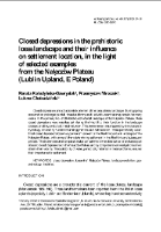- Tytuł:
-
Closed depressions in the prehistoric loess landscape and their influence on settlement location, in the light of selected examples from the Nałęczów Plateau (Lublin Upland, E Poland)
Archaeologia Polona Vol. 49 (2011-2013) - Autorzy:
-
Mroczek, Przemysław
Kołodyńska-Gawrysiak, Renata
Chabudziński, Łukasz - Data publikacji:
- 2013
- Wydawca:
- Institute of Archaeology and Ethnology Polish Academy of Sciences
- Słowa kluczowe:
-
loess relief
Nałęczów Plateau (Poland)
landscape evolution
depresje zamknięte
pokrywa lessowa
geoarcheologia
geoarcheology
Nałęczowski Płaskowyż (Polska)
ewolucja krajobrazu
Neolithic
neolit
closed depression - Źródło:
-
http://iaie.katalog.pan.pl/ipac20/ipac.jsp?profile=iaepan&index=BOCLC&term=ee95400522
IAiE PAN, sygn. P 356
IAiE PAN, call no. P 357
IAiE PAN, sygn. P 357
IAiE PAN, call no. P 358
IAiE PAN, sygn. P 358
IAiE PAN, call no. P 356 - Język:
- angielski
- Prawa:
-
Prawa zastrzeżone - dostęp ograniczony
Rights Reserved - Restricted Access - Linki:
- https://rcin.org.pl/dlibra/publication/edition/61746/content Link otwiera się w nowym oknie
- Dostawca treści:
- RCIN - Repozytorium Cyfrowe Instytutów Naukowych
- Inne
Menu główne
Wyszukiwarka
Treść główna

